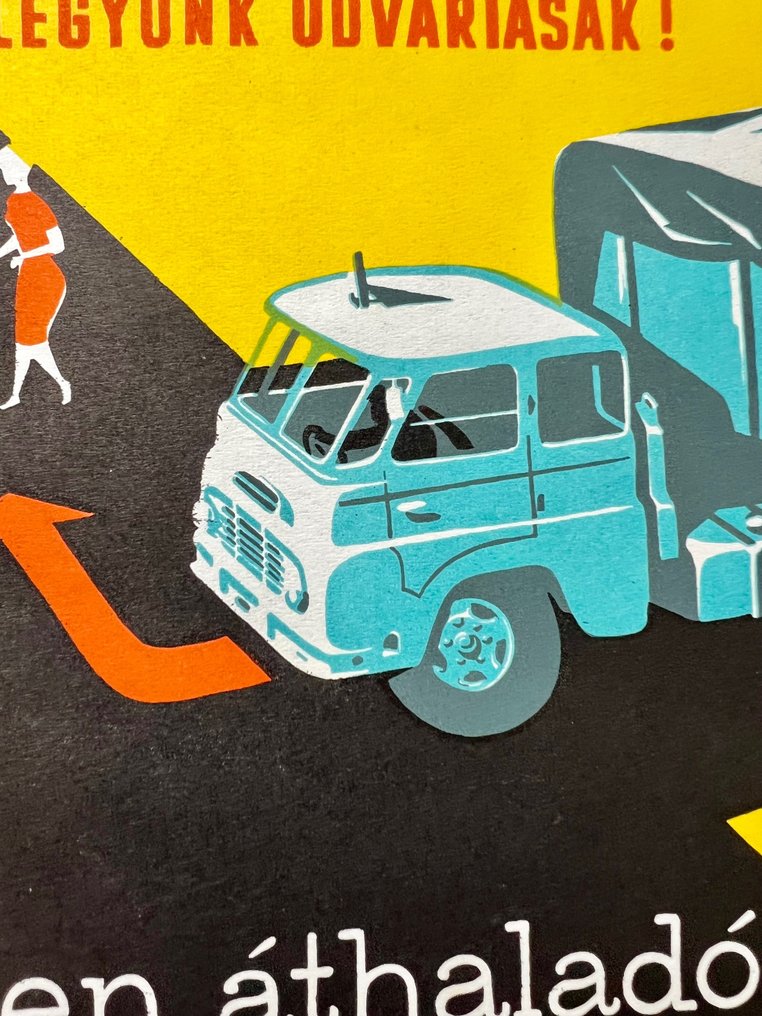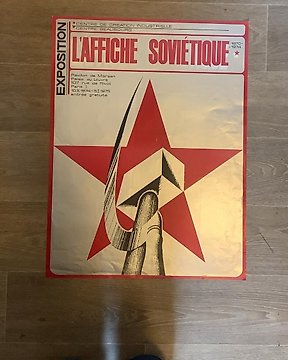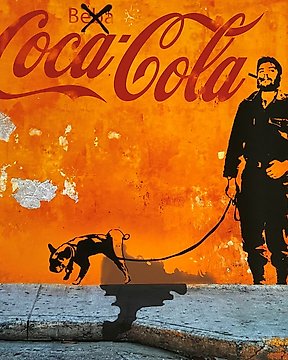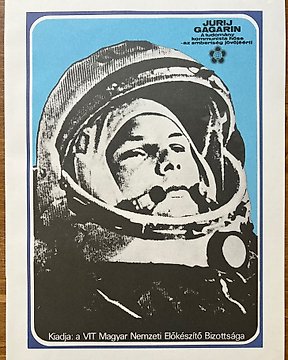Everything as expected - thanks !
Zobacz tłumaczenieJózsef Fogas - School education or safety poster - lithography, traffic rules, communist, USSR, Csepel Truck, - Lata 60.
Nr 85269859





Very well preserved 100% original poster from the emblematic Kőbánya industrial district
Litography
No other item of this available worldwide!
TRAM POSTER
Tram poster is a rarity genre in the devlopment of poster art. It was mostly wide spread in Hungary and also, but less frequently, in other Center/Easter European countries before the collapse of the Soviet Union where tram as public transport was commonly used by citizens in cities.
-
The tram posters are true personalities: sort of English ladies among the advertising spaces. This small advertising type spread from Germany in the 1920s and soon became a constant feature on Budapest trams as well. Inspired by a German example, a separate space was created inside the tram cars for their placement, on the inclined surfaces between the windows and the ceiling.
Last Picture: The appearance of tram posters coincided with the golden age of Hungarian poster art: the interior of trams featured works by numerous renowned artists.
Alongside various commercial messages, educational topics often found their place, drawing attention to civilized or safe travel practices, especially needed in the post-war period due to overcrowded, poorly maintained trains, and undisciplined passengers leading to many accidents.
Providing high visibility, tram posters were excellent for spreading propaganda messages from the beginning. In the 1950s and 60s, following the spirit of Soviet cultural policy, numerous posters were created, but commercial messages gradually displaced them from passenger spaces.
——-
Fogas József, the late father of the person mentioned, was an outstanding boxer in the 1920s and 30s.
A few years after graduating, he successfully applied to the Applied Graphics Department of the Hungarian College of Applied Arts, specializing in typography and graphic design. He graduated as a designer artist in 1974. In 1970, he won a political poster competition, and his winning artwork could be seen on the streets. From 1970, he participated every two years in the Warsaw Biennale. As a result, Andy Warhol noticed his work in 1974 and invited him to an American exhibition. However, he couldn't attend because, according to the regulations at the time, he would have needed permission from the Hungarian National Bank to send his works, which he didn't receive.
He regularly designed book covers (for Magvető and Örkény series), film posters (Partisans, Love in the War), company logos, emblems (Bútorért), and took part in designing graphics for almost all Hungarian and foreign exhibitions organized by HUNGEXPO.
He was a member of the Hungarian Days in Hamburg held in 1982, for which the emblem was a cube in the shape of a hay bale (one of his professors at the college was Ernő Rubik). He was also part of the award-winning design collective for the OMÉK Exhibition and Fair. The emblem he designed for OMÉK served as the logo for the fair for many years. He worked in Plovdiv (hunting fair), Paris, Nitra, České Budějovice, London, Copenhagen, Kiel, Moscow, Klagenfurt, and Odessa. His last foreign assignment was in Salzburg in November 1985
-
About Hungarian Poster Art
Hungarian poster art has long been celebrated for its unique and captivating style, making it a significant cultural and artistic movement in the world. From the late 19th century to the present day, Hungarian poster art has left an indelible mark on the global art scene, with its innovative techniques, bold designs, and powerful messages.
One of the highlights of Hungarian poster art is its ability to seamlessly blend various artistic styles and influences. The movement drew inspiration from a wide range of sources, including Art Nouveau, Constructivism, and Surrealism, resulting in a diverse and eclectic body of work. Artists such as Mihály Bíró, József Bottlik, and István Irsai pushed the boundaries of traditional poster design, experimenting with typography, color, and composition to create visually striking and thought-provoking pieces.
Another notable aspect of Hungarian poster art is its emphasis on storytelling and narrative. Unlike many other countries' posters, which primarily served as advertising tools, Hungarian posters often conveyed a deeper meaning or social commentary. They were not just meant to sell products but also to engage viewers intellectually and emotionally. This storytelling approach allowed Hungarian poster art to transcend its commercial purpose and become a powerful medium for social and political expression.
The importance of Hungarian poster art in the world cannot be overstated. During the early 20th century, Hungary was at the forefront of graphic design, and its posters gained international recognition and acclaim. The Budapest School, a group of Hungarian artists, revolutionized the field with their avant-garde approach, influencing poster art movements across Europe and beyond. Their innovative techniques and artistic vision set new standards for poster design, inspiring generations of artists worldwide.
Furthermore, Hungarian poster art played a crucial role in shaping public opinion and mobilizing society. In times of political turmoil and social change, posters became a powerful tool for propaganda and activism. During World War II and the Hungarian Revolution of 1956, posters were used to rally support, convey messages of resistance, and document historical events. The ability of Hungarian artists to capture the spirit of the times and communicate complex ideas through visual imagery made their posters an integral part of the nation's cultural and political identity.
Today, Hungarian poster art continues to thrive, with contemporary artists carrying on the legacy of their predecessors. The Hungarian Poster Museum in Budapest showcases the rich history and evolution of this art form, attracting visitors from around the world. The enduring appeal and influence of Hungarian poster art can be seen in the works of renowned artists like Tibor Helényi and István Orosz, who have successfully merged traditional techniques with modern aesthetics.
In conclusion, Hungarian poster art stands as a testament to the country's artistic prowess and cultural heritage. Its unique style, emphasis on storytelling, and ability to provoke thought and emotion have made it an important and influential movement in the world. From its early beginnings to the present day, Hungarian poster art continues to captivate audiences and inspire artists, leaving an indelible mark on the global art scene.
—
Please note that our company was founded in 1994 and it is internationally trackable. Invoice is available upon request.
Our team consists of members with university degree of art, painting valuation experts and experienced art&antique dealers
Feel free to ask as much as you want. Lifetime warranty is available for all items originality.
Shipping is with insurance and in tube, rolled.
Very well preserved 100% original poster from the emblematic Kőbánya industrial district
Litography
No other item of this available worldwide!
TRAM POSTER
Tram poster is a rarity genre in the devlopment of poster art. It was mostly wide spread in Hungary and also, but less frequently, in other Center/Easter European countries before the collapse of the Soviet Union where tram as public transport was commonly used by citizens in cities.
-
The tram posters are true personalities: sort of English ladies among the advertising spaces. This small advertising type spread from Germany in the 1920s and soon became a constant feature on Budapest trams as well. Inspired by a German example, a separate space was created inside the tram cars for their placement, on the inclined surfaces between the windows and the ceiling.
Last Picture: The appearance of tram posters coincided with the golden age of Hungarian poster art: the interior of trams featured works by numerous renowned artists.
Alongside various commercial messages, educational topics often found their place, drawing attention to civilized or safe travel practices, especially needed in the post-war period due to overcrowded, poorly maintained trains, and undisciplined passengers leading to many accidents.
Providing high visibility, tram posters were excellent for spreading propaganda messages from the beginning. In the 1950s and 60s, following the spirit of Soviet cultural policy, numerous posters were created, but commercial messages gradually displaced them from passenger spaces.
——-
Fogas József, the late father of the person mentioned, was an outstanding boxer in the 1920s and 30s.
A few years after graduating, he successfully applied to the Applied Graphics Department of the Hungarian College of Applied Arts, specializing in typography and graphic design. He graduated as a designer artist in 1974. In 1970, he won a political poster competition, and his winning artwork could be seen on the streets. From 1970, he participated every two years in the Warsaw Biennale. As a result, Andy Warhol noticed his work in 1974 and invited him to an American exhibition. However, he couldn't attend because, according to the regulations at the time, he would have needed permission from the Hungarian National Bank to send his works, which he didn't receive.
He regularly designed book covers (for Magvető and Örkény series), film posters (Partisans, Love in the War), company logos, emblems (Bútorért), and took part in designing graphics for almost all Hungarian and foreign exhibitions organized by HUNGEXPO.
He was a member of the Hungarian Days in Hamburg held in 1982, for which the emblem was a cube in the shape of a hay bale (one of his professors at the college was Ernő Rubik). He was also part of the award-winning design collective for the OMÉK Exhibition and Fair. The emblem he designed for OMÉK served as the logo for the fair for many years. He worked in Plovdiv (hunting fair), Paris, Nitra, České Budějovice, London, Copenhagen, Kiel, Moscow, Klagenfurt, and Odessa. His last foreign assignment was in Salzburg in November 1985
-
About Hungarian Poster Art
Hungarian poster art has long been celebrated for its unique and captivating style, making it a significant cultural and artistic movement in the world. From the late 19th century to the present day, Hungarian poster art has left an indelible mark on the global art scene, with its innovative techniques, bold designs, and powerful messages.
One of the highlights of Hungarian poster art is its ability to seamlessly blend various artistic styles and influences. The movement drew inspiration from a wide range of sources, including Art Nouveau, Constructivism, and Surrealism, resulting in a diverse and eclectic body of work. Artists such as Mihály Bíró, József Bottlik, and István Irsai pushed the boundaries of traditional poster design, experimenting with typography, color, and composition to create visually striking and thought-provoking pieces.
Another notable aspect of Hungarian poster art is its emphasis on storytelling and narrative. Unlike many other countries' posters, which primarily served as advertising tools, Hungarian posters often conveyed a deeper meaning or social commentary. They were not just meant to sell products but also to engage viewers intellectually and emotionally. This storytelling approach allowed Hungarian poster art to transcend its commercial purpose and become a powerful medium for social and political expression.
The importance of Hungarian poster art in the world cannot be overstated. During the early 20th century, Hungary was at the forefront of graphic design, and its posters gained international recognition and acclaim. The Budapest School, a group of Hungarian artists, revolutionized the field with their avant-garde approach, influencing poster art movements across Europe and beyond. Their innovative techniques and artistic vision set new standards for poster design, inspiring generations of artists worldwide.
Furthermore, Hungarian poster art played a crucial role in shaping public opinion and mobilizing society. In times of political turmoil and social change, posters became a powerful tool for propaganda and activism. During World War II and the Hungarian Revolution of 1956, posters were used to rally support, convey messages of resistance, and document historical events. The ability of Hungarian artists to capture the spirit of the times and communicate complex ideas through visual imagery made their posters an integral part of the nation's cultural and political identity.
Today, Hungarian poster art continues to thrive, with contemporary artists carrying on the legacy of their predecessors. The Hungarian Poster Museum in Budapest showcases the rich history and evolution of this art form, attracting visitors from around the world. The enduring appeal and influence of Hungarian poster art can be seen in the works of renowned artists like Tibor Helényi and István Orosz, who have successfully merged traditional techniques with modern aesthetics.
In conclusion, Hungarian poster art stands as a testament to the country's artistic prowess and cultural heritage. Its unique style, emphasis on storytelling, and ability to provoke thought and emotion have made it an important and influential movement in the world. From its early beginnings to the present day, Hungarian poster art continues to captivate audiences and inspire artists, leaving an indelible mark on the global art scene.
—
Please note that our company was founded in 1994 and it is internationally trackable. Invoice is available upon request.
Our team consists of members with university degree of art, painting valuation experts and experienced art&antique dealers
Feel free to ask as much as you want. Lifetime warranty is available for all items originality.
Shipping is with insurance and in tube, rolled.
- 55
- 11
- 5
el objeto estaba peor y las fotos no mastraban los desperfectos
Zobacz tłumaczenieErg goede ervaring met deze verkoper. wederom blij met deze aankoop.
Zobacz tłumaczeniealles prima, die Versandkosten sind vielleicht etwas hoch, doch sonst super
Zobacz tłumaczeniel'affiche achetée ne correspond pas à celle commandée . le vendeur ne répond pas le vendeur à réparé son erreur . merci
Zobacz tłumaczenieDe litho is in goede staat aangekomen. Hij is minder beschadigd dan ik verwacht had. Blij mee. Het duurde wel wat lang voordat hij er was (14 dagen), maar dat was de moeite waard van het wachten.
Zobacz tłumaczenieThanks a lot :) i am very glad you are happy with it.
Excellente communication, vendeur très sympa, objet top . Merci !!!
Zobacz tłumaczenieAlles gut.
Zobacz tłumaczenieEverything OK!
Zobacz tłumaczenieOttimo stato e impeccabilmente spedito. Molto bene
Zobacz tłumaczenieGrazie mille :)
100 % in orde - bedankt !
Zobacz tłumaczenieDal vivo non è come mi aspettavo.
Zobacz tłumaczeniethe saler never answered and finally the payments returned. not recommended!!!!!
Zobacz tłumaczenieUpdate. You took 2 months to send, and after I receive the pack an other seller Fromm the same country put on catawiki the same piece. I take your word and lets cancel the operation. I
Zobacz tłumaczenieNo problem. Let’s cencel, please send me back the item, well Packed. Insured. And write to Catawiki about this. Thank. With the most respect I sent you a photo about the item, which I told you about it is not the same, you agreed, you said it was urgent as it was supposed to be a gift, you confirmed. I digged the into all my resoureces to find you a similar one at the side of the country. I already ended up paying more than I got. We exchanged many messeges. And you end up giving me a negative? We also talked about cencelling the sale. We still cpuéd have done it before all this. If I knew it was going to end up like this, I would have let it go in the very beginning.
Todo perfecto!
Zobacz tłumaczenieStampa carina, ma non forse non originale come descritto…Tempi lunghi di consegna
Zobacz tłumaczenieBouna giornata! The poster is 100% original vintage, without any doubt. You can also contact the auction house I bought it from just message me. Please modify your comment and review accordingly. I do not want my potential buyers to be misled. I am truly sorry for the late delivery, but it is up to the postal service and not me, I have delivered it ot post office is time. Thank you and regards, M
Happy with another beautiful poster, again carefully wrapped.
Zobacz tłumaczenieFast shipping, great quality! Thank you :)
Zobacz tłumaczenieVenditore serio e attento. Confezione perfetta, oggetto corrisponde perfettamente alla descrizione. Risposte immediate alle richieste. Non è lui il responsabile dei ritardi delle poste ungheresi.
Zobacz tłumaczenieItem was delivered well packed and in good condition, and timely. Tracking Info was provided. Great service.
Zobacz tłumaczeniePoster is absolut beautiful, with clear lines and vibrant colors. Delivery great. We‘re very happy with our purchase!
Zobacz tłumaczenieDelivery was in good condition. Many thanks to seller for good service.
Zobacz tłumaczenieParfait
Zobacz tłumaczeniearrived in a good state well packed took a bit long to come But at the end everything fine thank you anne
Zobacz tłumaczenierendben van
Zobacz tłumaczenie- 55
- 11
- 5
Everything as expected - thanks !
Zobacz tłumaczenie








